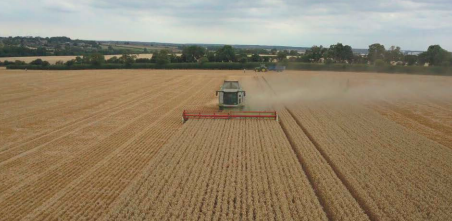Abstract from D. L. Antille, W. C. T. Chamen, J. N. Tullberg, R. Lal
The drive toward adoption of conservation agriculture to reduce costs and increase production sustainably causes concern due to the potentially negative effects of increased soil compaction. Soil compaction reduces aeration, water infiltration, and saturated hydraulic conductivity and increases the risk of waterlogging. Controlled traffic farming (CTF) is a system in which:
• all machinery has the same or modular working and track width so that field traffic can be confined to the least possible area of permanent traffic lanes,
• all machinery is capable of precise guidance along those permanent traffic lanes, and
• the layout of the permanent traffic lanes is designed to optimize surface drainage and logistics.
Without CTF, varying equipment operating and track widths translate into random traffic patterns, which can cover up to 85% of the cultivated field area each time a crop is produced. Nitrous oxide (N2O) is the greatest contributor to agriculture’s greenhouse gas (GHG) emissions from cropping, and research suggests that its production increases significantly under conditions of high (>60%) water-filled porosity when nitrate (mainly from fertilizer N) and carbon (usually from crop residues) are available.
Self-amelioration of soils affected by compaction occurs slowly from the surface downward; however, the rate of amelioration decreases with increase in depth. Consequently, all soils in non-CTF systems in mechanized agriculture are prone to some degree of compaction, which compromises water infiltration, increases the frequency and duration of waterlogged conditions, reduces gaseous exchange between soil and the atmosphere, inhibits root penetration and exploitation of nutrients and water in the subsoil, and enhances N2O emissions.

Adoption of CTF increases soil porosity in the range of 5% to 70%, water infiltration by a factor of 4, and saturated hydraulic conductivity by a factor of 2. The greater cropping opportunity and enhanced crop growth for given fertilizer and rainfall inputs offered by CTF, coupled with no-tillage, provide potential for enhanced soil carbon sequestration. Reduced need and intensity of tillage, where compaction is avoided, also helps protect soil organic matter in stable aggregates, which may otherwise be exposed and oxidized.
There is both circumstantial and direct evidence to suggest that improved soil structural conditions and aeration offered by CTF can reduce N2O emissions by 20% to 50% compared with non-CTF. It is not compaction per se that increases the risk of N2O emissions but rather the increased risk of waterlogging and increase in water-filled pore space. There may be an elevated risk of GHG emissions from the relatively small area of permanent traffic lanes (typically <20% of total cultivated area) if these are not managed appropriately. Quantification of the benefits of compaction avoidance in terms of GHG emissions may be possible through the use of well-developed models.
Read the full paper here: http://actfa. net/wp-content/uploads/2015/07/ antille2015.pdf or click the QR code here:
